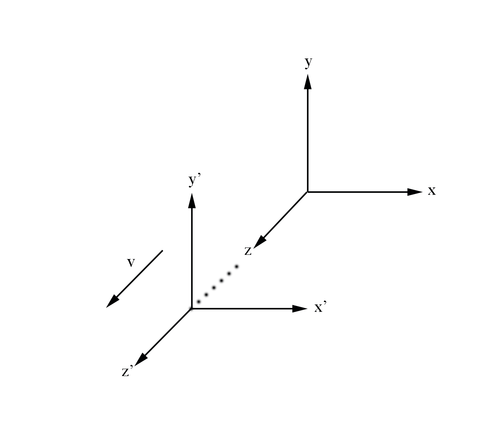Difference between revisions of "Relativistic Frames of Reference"
Jump to navigation
Jump to search
| Line 12: | Line 12: | ||
From the Galilean description of motion for a frame of reference moving relative to another frame considered stationary we know that | From the Galilean description of motion for a frame of reference moving relative to another frame considered stationary we know that | ||
| + | |||
| + | |||
| + | |||
| + | <center>[[File:GalileanFrames.png|thumb|center|500px|alt=Galilean Frames of Reference|'''Figure 2.1:''' Primed reference frame moving in the z direction with velocity v. ]]</center> | ||
| + | |||
| + | |||
<center><math>t= t'</math></center> | <center><math>t= t'</math></center> | ||
| Line 22: | Line 28: | ||
| + | |||
| + | Using Einstein's Theory of Relativity, we know that the speed of light is a constant, c, for all reference frames. In the unprimed frame, from the definition of speed: | ||
| + | |||
| + | |||
| + | <center><math>speed=\frac{\Delta Distance}{\Delta Time}</math></center> | ||
| + | |||
| + | |||
| + | <center><math>c=\frac{\Delta d}{\Delta t}</math></center> | ||
| + | |||
| + | |||
| + | where | ||
| + | |||
| + | <center><math>c=3E8\ m/s</math></center> | ||
| + | |||
| + | Using the distance equation in a Cartesian coordinate system, the change in distance becomes | ||
| + | <center><math>c=\frac{\sqrt{(\Delta x)^2+(\Delta y)^2+(\Delta z)^2}{\Delta t}</math></center> | ||
| − | |||
Revision as of 03:10, 3 June 2017
Relativistic Frames of Reference
From the Galilean description of motion for a frame of reference moving relative to another frame considered stationary we know that
Using Einstein's Theory of Relativity, we know that the speed of light is a constant, c, for all reference frames. In the unprimed frame, from the definition of speed:
where
Using the distance equation in a Cartesian coordinate system, the change in distance becomes
